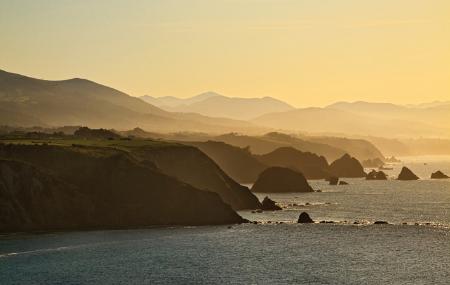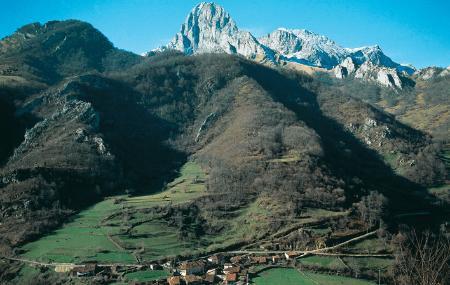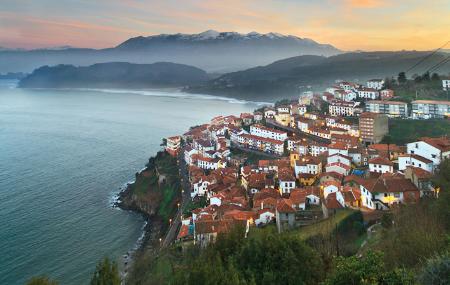
- Address Itinerary municipalities: Vegadeo, San Tirso de Abres, Valdés, Tineo, Cudillero, Pravia, Salas, Oviedo, Riosa, Luanco, Colunga, Piloña, Caravia, Ponga, Ribadesella, Llanes, Ribadedeva, Peñamellera Alta y Peñamellera Baja
- Duration Duration: 7 days
- Distance Distance: 640,8 kms
- Difficulty Difficulty: Short
- Start point Start point: A Veiga/Vegadeo
- Route type Route type: car
- Layout of the route Layout of the route: Download kml
Asturias is ideal for combining sea and mountain trips, due to the proximity between the two.
The overwhelming proximity of the mountains to the sea, which shapes the Asturian landscape, reaches its peak in the east, where the Picos Mountains descend to the coast in barely 20 kilometres. The Principality is an ideal region for combining sea and mountain trips, with the rivers that connect them, whether to enjoy the trails and beaches in summer or to explore the coastline and discover the heritage in winter.
Route
A Veiga/Vegadeo - San Tiso - Beach of Barayo
Day 1: The itinerary begins in the West. The starting point for the first day is A Veiga/Vegadeo, a town halfway between the sea and the mountains where you can visit the church of Nuestra Señora de la Asunción, the emblematic Town Hall building, located in a 19th century urban expansion, or the House of Elisa and Luis Villamil, which is the headquarters of the House of Culture. In the district of Abres, we find the Palace of Miranda, built in the 18th century on top of an earlier construction. The old Monastery of San Esteban de Piantón is mentioned as early as 1079, but the oldest remains still standing today date from the 16th century. From A Veiga/Vegadeo you can go to San Tiso, on the N-640, to visit the Eo Fishing Interpretation Centre, located on the first floor of the old Instruction Centre, founded by the emigrants in Havana. San Tiso is an ideal place to get to know the landscape, through the Senda del Eo (which takes advantage of an old railway box), twelve kilometres long, or the Route to Pena do Encanto, where, according to a legend, an enchanted lady comes out of the rock with a silver comb every night of San Juan. From San Tiso, we set off towards the coast of Valdes, with its undoubted charm and Nature Reserves such as Barayo, which we will enjoy on the second day.
Barayo beach - Luarca/Ḷḷuarca - Navelgas
Day 2: A brief incursion into the land of the vaqueira is worth at least a day's journey, during which you will cover the kilometres that connect Valdés and Tineo. The coast is home to some of the most beautiful beaches on the Asturian coast, such as the Barayo Nature Reserve, on the border with Navia, or the sandy beaches of Otur, Cadavedo and Cueva, which have all the services. And also a town like Ḷḷuarca, where the port, the beaches, the cemetery, the lighthouse, the tide table, the kissing bridge, the historic quarter, and its Indian villas make up an ideal place for strolling and enjoying the seafaring atmosphere. From the fishing village of Ḷḷuarca, along the AS-219, in the direction of Pola de Allande, you reach the "brañas vaqueiras", including Aristébano, known for its famous "boda vaqueira" (cowboy wedding). Twenty-two kilometres away is the Museo Vaqueiro, which explains this culture marked by the transhumance of livestock and is divided into two parts. The first is located in the Barzanietxa neighbourhood, to the west of the village of Naraval, and the second in Folgueras del Río. These facilities are completed with four organised routes through the seven "brañas" of the area, about which the traveller can obtain information in the museum. To end this intense day, less than five kilometres away is the Gold Museum in Navelgas.
Navelgas - Cudillero - Pravia - Salas
Day 3: The day begins at El Silencio beach, known as Gavieiru or Gavieiro, in Castañeras, sixteen kilometres west of Cudillero. The car must be parked in a small designated area and continue walking for about ten minutes. The fishing village of Cudillero, one of the most unique in the region, is well worth a visit. This trip can also be a good excuse to familiarise yourself with traditional salmon fishing. Less than half an hour away, via the Cantabrian motorway (A-8) and the AS-16, you will find Pravia and its Salmon House, which offers free guided tours but is only open if you book in advance. Nearby, in Cornellana (council of Salas), is the Senda del Salmón (Salmon Trail), an ideal way to familiarise yourself with the surroundings. This route is flat, measures eleven kilometres and connects Cornellana with Bárcena. From Cornellana you can also walk to the Quinzanas Bridge, a fourteen-kilometre round trip. Nearby is Salas, capital of the council, a medieval town of great importance on the Pilgrim's Way, whose historic quarter preserves architectural 'jewels' such as the Collegiate Church or the Castle of Valdés Salas - birthplace of the founder of the University of Oviedo, Fernando de Valdés Salas - and to sweeten this walk into the past, there is nothing better than some 'carajitos del profesor', a typical local sweet.
Salas - Oviedo/Uviéu - Riosa
Day 4: From Oviedo/Uviéu you can see the shadow of the Sierra del Aramo Protected Landscape, the green border of the southern part of the central metropolitan area of Asturias. Three peaks stand out on the horizon above 1,500 metres: El Gamoniteiru, La Gamonal and El Barriscal. The summit of El Angliru, which can be reached by car on the N-630 in the direction of Mieres, and then on the AS-231 in the direction of Riosa, is a good starting point for excursions. On the other hand, if you are prepared to travel more kilometres, you can go to one of the two Asturian ski resorts, Valgrande-Pajares (60 kilometres from Oviedo/Uviéu) or Fuentes de Invierno (65 kilometres). In winter you can enjoy the snow and, at other times of the year, get to know the mountains.
La Vega - Rifabar
Day 5: Sea and mountains are also Colunga and Piloña, two municipalities that represent almost the gateway to the East. Colunga has beaches such as La Griega, with a dinosaur ichnite route, or La Isla. A few metres away, La Espasa, a paradise for hikers, surfers and kite-flying enthusiasts, belongs to the neighbouring council of Caravia. From the coast, you can reach the interior along the AS-258 mountain road, which ends very close to L'Infiestu, the capital of Piloña. Halfway along the route, you can also take a different route, the AS-358, which crosses the Sierra del Sueve and Borines/Boriñes and ends near Villamayor. In L'Infiestu, you will find the church of San Antonio and the Casa del Tiempo, and just one kilometre along the AS-254, the Sanctuary of the Virgen de la Cueva. If you prefer to go into the mountains, a good option is the recreational area of La Pesanca, located among woods and from which several routes start. This natural space can be reached by the PL-4 road, a local road that connects with the N-634, a few kilometres from the capital. The route, which follows the course of the river Infierno, takes the traveller into the Redes Biosphere Reserve.
Rifabar - Ribadesella/Ribeseya
Day 6: From Piloña towards the east, there is another lush mountain area to discover, the one preserved by Ponga and its Natural Park. Thirty-seven percent of this territory is forest. One of the recommended routes is that of the Bosque de Peloño, a path of almost twenty-five kilometres that crosses an area declared a Partial Nature Reserve and whose most attractive elements include a large beech forest. You can also enjoy nature by rafting in the Viboli and Carangas canyons, or canyoning. Just one hour from Ponga (fifty-four kilometres), the Bay of Biscay enters Ribadesella/Ribeseya through its estuary. A stroll along Santa María beach and along the port to the Ermita de la Guía hermitage reconciles the traveller with the sea.
Ribadesella/Ribeseya - Alles
Day 7: The last day follows the opposite direction, from the sea breeze to the wind of the Picos. The bufones dot the coast of Llanes. They are cavities excavated in the rock by the sea, which emerges to the surface through cracks, like chimneys. They concentrate the sound caused by the lapping of the waves. On swell days, even the steam from the water can be heard. The most famous are those of Arenillas (one kilometre from Puertas de Vidiago), Santiuste (near Buelna) and Guadamía. The journey continues towards Bustio, the last Asturian fishing port, almost on the border with Cantabria, to take the N-621 road towards Peñamellera Baja. You will come across the Sauceda de Buelles, a forest that borders the Cares between El Mazo, Narganes and Buelles. Travellers can also fish in season if they have a licence. The last stop is Peñamellera Alta, which preserves some of the best fishing preserves, such as Niserias or Rubena. Mountain biking enthusiasts have a unique opportunity to enjoy the route between Mier and La Molinuca. Those who prefer a more leisurely activity can visit the Aula de la Miel, in Alles, which is a centre for the dissemination of beekeeping.
Map
Itinerary
A Veiga/Vegadeo - San Tiso - Playa de Barayo - Luarca/Ḷḷuarca - Navelgas - Cudillero - Pravia - Salas - Oviedo/Uviéu - Riosa - La Vega - Rifabar - Ribadesella/Ribeseya - Alles




